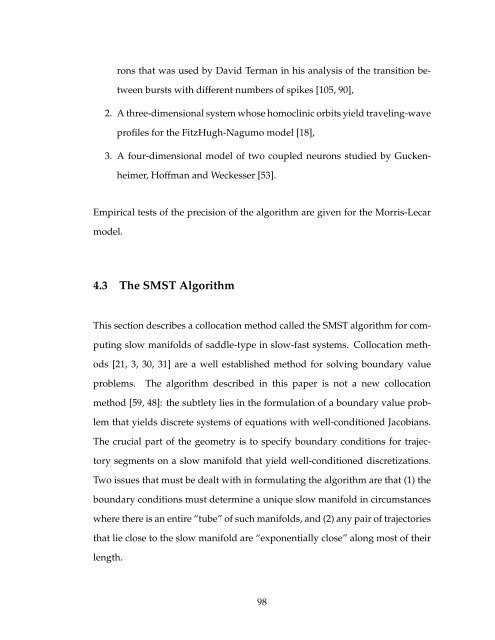multiple time scale dynamics with two fast variables and one slow ...
multiple time scale dynamics with two fast variables and one slow ...
multiple time scale dynamics with two fast variables and one slow ...
You also want an ePaper? Increase the reach of your titles
YUMPU automatically turns print PDFs into web optimized ePapers that Google loves.
ons that was used by David Terman in his analysis of the transition be-<br />
tween bursts <strong>with</strong> different numbers of spikes [105, 90],<br />
2. A three-dimensional system whose homoclinic orbits yield traveling-wave<br />
profiles for the FitzHugh-Nagumo model [18],<br />
3. A four-dimensional model of <strong>two</strong> coupled neurons studied by Gucken-<br />
heimer, Hoffman <strong>and</strong> Weckesser [53].<br />
Empirical tests of the precision of the algorithm are given for the Morris-Lecar<br />
model.<br />
4.3 The SMST Algorithm<br />
This section describes a collocation method called the SMST algorithm for com-<br />
puting <strong>slow</strong> manifolds of saddle-type in <strong>slow</strong>-<strong>fast</strong> systems. Collocation meth-<br />
ods [21, 3, 30, 31] are a well established method for solving boundary value<br />
problems. The algorithm described in this paper is not a new collocation<br />
method [59, 48]: the subtlety lies in the formulation of a boundary value prob-<br />
lem that yields discrete systems of equations <strong>with</strong> well-conditi<strong>one</strong>d Jacobians.<br />
The crucial part of the geometry is to specify boundary conditions for trajec-<br />
tory segments on a <strong>slow</strong> manifold that yield well-conditi<strong>one</strong>d discretizations.<br />
Two issues that must be dealt <strong>with</strong> in formulating the algorithm are that (1) the<br />
boundary conditions must determine a unique <strong>slow</strong> manifold in circumstances<br />
where there is an entire “tube” of such manifolds, <strong>and</strong> (2) any pair of trajectories<br />
that lie close to the <strong>slow</strong> manifold are “exp<strong>one</strong>ntially close” along most of their<br />
length.<br />
98
















